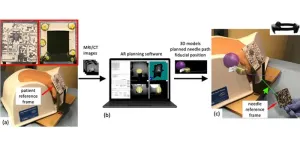(Press-News.org)
Study Suggests EHR-Focused Interventions Can Significantly Reduce Unnecessary Urine Cultures Among Hospital Patients
Initiative highlighted in AJIC provides model for resource-limited institutions to decrease overdiagnosis and overtreatment of asymptomatic bacterial infections
Arlington, Va., March 2, 2023 – Physicians in the largest safety-net hospital system in the United States used two electronic health record (EHR)-focused interventions to significantly reduce inappropriate urine cultures among hospitalized patients. Findings from their study, published in the American Journal of Infection Control (AJIC), suggest low-resource approaches could help reduce the overdiagnosis and overtreatment of asymptomatic bacteriuria.
“This quality improvement initiative revealed that low-effort EHR interventions can successfully reduce unnecessary urine-culture orders to create better, more efficient care, particularly for vulnerable patient populations,” said Mona Krouss, MD, AVP, Value and Patient Safety, NYC Health + Hospitals (NYC H+H), and the lead author on the published study. “We believe this successful intervention can be a model for other institutions, and may be especially valuable in resource-limited, safety-net systems.”
Asymptomatic bacteriuria (ASB), the isolation of bacteria in the absence of symptoms or signs of a urinary tract infection (UTI), is overdiagnosed and overtreated in the United States. While the United States Preventive Services Task Force, Infectious Diseases Society of America, and multiple Choosing Wisely Lists all recommend not treating ASB given the lack of benefit for all but a few populations, inappropriate urine culture tests and subsequent treatment are common. Overtreatment of ASB leads to harm, including adverse effects from antibiotics, antibiotic resistance, and increased length of hospital or facility stay.
Dr. Krouss and colleagues at NYC H+H implemented a quality improvement project intended to decrease unnecessary urine culture orders across their 11 acute care hospitals in a relatively nonintrusive, efficient manner. The intervention consisted of changing the electronic medical record (EMR) ordering screen for urine cultures to require the entry of an indication for the culture, and a Best Practice Advisory (BPA) that appeared when urine cultures were ordered for patients with urinary catheters who were hospitalized for more than 48 hours. The researchers then compared urine-culture ordering preintervention (6/2020 to 10/2021) to postintervention (12/2021 to 8/2022). They also assessed variation in hospitals and clinics, as well as BPA responses by clinician type and specialty.
During the study period, the BPA triggered 4,822 times, with 552 urine culture orders removed, an accept rate of 11.4%. All 11 hospitals saw a statistically significant reduction in urine culture tests. Specifically, urine culture orders in the inpatient setting decreased from 32.68 per 1,000 patient days preintervention to 25.85 per 1,000 patient days postintervention, a 20.9% reduction. The researchers noted that reductions in urine culture ordering rates were highly variable among the 11 hospitals.
For those patients with a urinary catheter tested 48 hours after admission, urine culture rates decreased from 2.36 per 1,000 patient days preintervention to 1.85 per 1,000 patient days postintervention, a 21.6% reduction. Rates of catheter-associated urinary tract infection (CAUTI) did not change pre- and postintervention (1.95 and 1.63, respectively, p = 0.1).
“These findings suggest that EHR-based clinical-decision support can be effective and scalable to improve care for patients with indwelling catheters and reduce excessive antibiotic use,” said Patricia Jackson, RN, BSN, CIC, FAPIC, 2023 APIC president. “Curbing antibiotic use is necessary to combat the growing threat of antibiotic resistance.”
About APIC
Founded in 1972, the Association for Professionals in Infection Control and Epidemiology (APIC) is the leading association for infection preventionists and epidemiologists. With more than 15,000 members, APIC advances the science and practice of infection prevention and control. APIC carries out its mission through research, advocacy, and patient safety; education, credentialing, and certification; and fostering development of the infection prevention and control workforce of the future. Together with our members and partners, we are working toward a safer world through the prevention of infection. Join us and learn more at apic.org.
About AJIC
As the official peer-reviewed journal of APIC, The American Journal of Infection Control (AJIC) is the foremost resource on infection control, epidemiology, infectious diseases, quality management, occupational health, and disease prevention. Published by Elsevier, AJIC also publishes infection control guidelines from APIC and the CDC. AJIC is included in Index Medicus and CINAHL. Visit AJIC at ajicjournal.org.
NOTE FOR EDITORS
“Choosing Wisely Initiative for reducing Urine Cultures for Asymptomatic Bacteriuria and Catheter-Associated Asymptomatic Bacteriuria in an 11-Hospital Safety Net System,” by Mona Krouss, MD and colleagues, was published online in AJIC on March 2, 2023. The article may be found at: https://doi.org/10.1016/j.ajic.2023.01.005
FIRST AUTHOR
Mona Krouss, MD (corresponding author: kroussm@nychhc.org)
Department of Quality and Safety, NYC Health + Hospitals, New York, NY, USA
# # #
END
Scientists at the University of Sussex have successfully trialed new biodegradable health sensors that could change the way we experience personal healthcare and fitness monitoring technology.
The team at Sussex have developed the new health sensors – such as those worn by runners or patients to monitor heart rate and temperature – using natural elements like rock salt, water and seaweed, combined with graphene. Because they are solely made with ingredients found in nature, the sensors are fully biodegradable, making them more environmentally friendly than commonly used rubber and plastic-based alternatives. Their natural ...
Des Plaines, IL — When compared to cocaine exposure alone, cocaine and ethanol exposure in emergency department (ED) patients with acute drug overdose was significantly associated with higher occurrence of cardiac arrest, higher mean lactate concentrations, and lower occurrence of myocardial injury. This is the conclusion of a study titled, Cocaethylene cardiotoxicity in emergency department patients with acute drug overdose published in the February issue of Academic Emergency Medicine (AEM), the peer-reviewed journal of the Society for Academic Emergency ...
According to the US Centers for Disease Control and Prevention, prostate cancer is the second leading cause of cancer death among men. One of the standard approaches for the diagnosis and treatment of prostate cancer involves transperineal (TP) biopsy. This involves inserting a needle through the perineum wall to collect tissue samples. Current methods for TP biopsy generally include a pre-operation MRI scan and a transrectal ultrasound. These images are then fused together and shown on a monitor to the urologist, who then inserts the needle. The needle insertion can be ...
A team of global experts has discovered new signals of natural selection in humans.
Led by UC Santa Barbara Tsimane Health and Life History Project co-director Michael Gurven, the team studied two populations living in the Bolivian Amazon rainforest — the Tsimane and the Moseten. Previous studies show that these tropical populations are exposed to many parasites and a variety of pathogens; at the same time, the Tsimane rarely suffer from cardiovascular diseases and dementia. This new research suggests that the Tsimane genome has undergone selection ...
A large Bronze Age debris deposit in Mycenae, Greece provides important data for understanding the history of animal resources at the site, according to a study published March 1, 2023 in the open-access journal PLOS ONE by Jacqueline Meier of the University of North Florida and colleagues.
Animals were an important source of subsistence and symbolism at the Late Bronze Age site of Mycenae in Greece, as evidenced by their depictions in art and architecture, but more research is needed on the animals ...
A survey study of U.S. college students provides new insights into factors associated with the tendency to engage in celebrity stalking behaviors. Maria Wong (Idaho State University, U.S.), Lynn McCutcheon (North American Journal of Psychology, U.S.), Joshua Rodefer (Mercer University, U.S.) and Kenneth Carter (Emory University, U.S.) present these findings in the open-access journal PLOS ONE on March 1, 2023.
Celebrities around the world deal with the threat of unwanted and threatening or intimidating attention or harassment—commonly known as stalking. A growing body of research is exploring and identifying factors that are associated ...
Most people find sharks threatening. Who doesn’t have an image in their mind of a menacing shark fin racing through the ocean in search of its next meal?
But it is the shark that is threatened.
According to Defenders of Wildlife, a national nonprofit dedicated to protecting imperiled species, 75% of shark species are threatened with extinction and up to 73 million sharks are being killed each year for their fins.
Habitats that were once secure places for sharks to give birth have also been affected. And the fact that sharks have long gestation periods, giving birth ...
**Strictly embargoed until 19:00 (GMT) Wednesday 1 March 2023**
Scientists discover how to prevent death of nerve cells in most common forms of MND and dementia
Researchers from the University of Sheffield’s Institute of Translational Neuroscience have discovered how to prevent the death of nerve cells and protect nerves from neurodegeneration in the most common forms of MND and frontotemporal dementia
The researchers used a peptide, a small assembly of amino acids or protein bricks, with a cell-penetrating ...
Black women at high risk of breast cancer face a variety of obstacles that may keep them from care that could prevent cancer and increase the chances they’ll survive if they develop the disease, new research has found.
A study from researchers at The Ohio State University provides insights into the factors that contribute to racial disparities in use of preventive measures, including genetic testing, prophylactic mastectomies and medication to thwart breast cancer.
In the new study, which appears today (March 1, 2023) in the journal PLOS ONE, the ...
A world-first model of paleoclimate and hydrology in Iran has highlighted favourable routes for Neanderthals and modern human expansions eastwards into Asia.
Published in PLOS ONE, the findings reveal for the first time that multiple humid periods in ancient Iran led to the expansions of human populations, opening dispersal route across the region, and the possible interactions of species such as Neanderthals and our own Homo sapiens.
Professor Michael Petraglia, a key researcher in the study, said historic humid ...





